Why you need a Mavenlink Alternative
There are no shortages of Mavenlink alternatives. Popular among mid-size and enterprise teams, Mavenlink finds uses across professional service businesses such as marketing, advertising, public relations, architecture, engineering, IT services, management consulting, and education.
Some users report the tool feels almost like a more modern version of Microsoft Project, with fewer bells and whistles. This is why Mavenlink isn’t the right choice for every team…and it may not be the best-suited tool for your needs. So, we’ve compiled a list of the top Mavenlink alternatives, with the pros and cons of each.
Ranking the top Mavenlink Alternatives
Let’s look at industry rankings. Workzone ranks #1 across the board against Mavenlink and other Mavenlink alternatives at leading software review sites Capterra, Software Advice, and GetApp by user reviews.
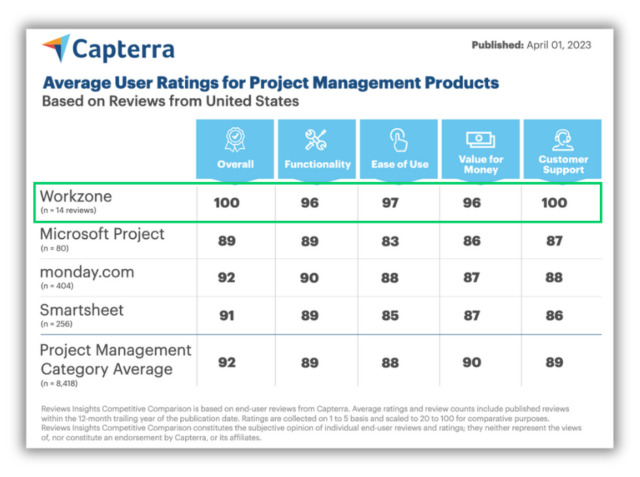
About the #1 Ranked Mavenlink Alternative: Workzone
Better visibility to your team’s work
While Mavenlink can handle moderately sized task lists, it lacks key visibility in seeing all projects.
Only Workzone lets users see all their projects in one glance on its Project Dashboard.
Expert project managers by your side
Mavenlink offers a free trial, but limited personalized onboarding and support.
Workzone provides unlimited support for every customer. No other software on the market offers such an extensive onboarding and training process included with their subscription
Learn more
Everything you need to manage your projects
Mavenlink offers an updated interface but lacks the most critical tools most teams need to be successful.
Perfected over 20 years, Workzone combines ease of use with robust functionality. Giving you access to advanced features that help you manage projects more successfully.
View the product tourTop 10 Mavenlink Alternatives
Mavenlink Alternatives FAQs
Mavenlink markets itself as a work management solution. Not only does it tackle project management, but the tool also supports resource management, project accounting, team collaboration, and business intelligence.
But, as with many robust tools, Mavenlink can seem overly complex and come with a very steep learning curve for new users. Some companies report managing and using the tool has created more work for their project managers.
- Supports detailed resource and task tracking
- Highly customizable on multiple data levels
- Includes detailed permissioning, which means enhanced security
- Comes with templates for tasks, checklists, schedules, budgets and more
- Outdated UI/UX and difficult to operate
- There is no “admin” user role so you cannot have one person manage the tool
- Sharing projects with team members is cumbersome
- The price is higher than many competitors
#1 Mavenlink Alternative Review: Workzone
Top 16 Mavenlink Alternatives for Project Management
1. Workzone
Based outside Philadelphia, Workzone has been a significant player in the project management world since 2002.
Pros: If you’re looking for a solution with a more user-friendly interface and higher adoption rates, then you should try Workzone. Your team will work smoothly and with less frustration than before. Designed to help manage projects more effectively, Workzone comes with unlimited support.
Compared to Mavenlink, Workzone:
- Includes project dashboards to provide teams with a portfolio view of all the projects
- Offers personalized to-do lists keep all team members on track
- Provides unlimited support and comprehensive onboarding ensures your team gets up to speed quickly
- Incorporates interactive Gantt Chart and Calendar views for more visual project tracking
- Has customizable project intake forms and reports so you can adapt them to your business needs
- Gives the ability to associate, share, and store documents by each project
- Works with different permission levels set by project or document so people see only what’s appropriate
- Assigns admin roles so you can have one or a few administrators manage the system
Cons: Some users have reported that the search functionality could be improved.
Review: “As an administrator, it has been essential for tracking work across departments and to manage timelines. Technical support has been excellent, and Workzone staff check in from time to time to learn what else we may need to do our work better. The software is constantly improving based on feedback, so we know we are always getting the best product available.” -Source: Software Advice
2. InMotionNow
InMotionNow is a workflow management solution for creative and marketing teams.
Pros: Similar to Proofhub, inMotionNow’s biggest asset is for teams handling a lot of creative project documents. The tool integrates with Adobe CC so that proofs can be submitted and reviewed in a central location. All comments, mentions, and files related to a project can easily be stored in one place.
Cons: The user-interface is a bit clunky, and users may struggle to adopt the software. inMotionNow doesn’t offer the customization or advanced project management features offered by many other tools on this list.
Pricing: Only available upon request
3. Proofhub
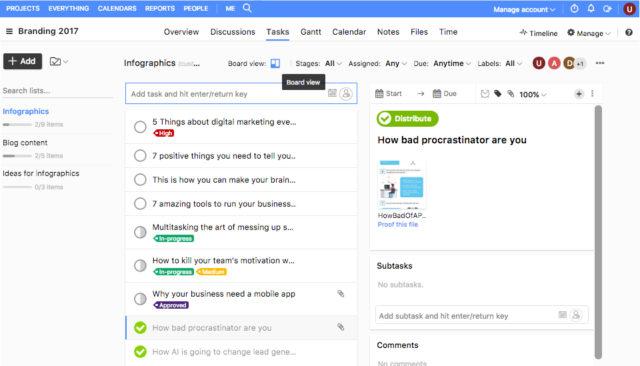
Proofhub is a project planning software tool launched in 2011.
Pros: Proofhub has advanced markup and proofing capabilities, making it a great option for teams that create a lot of design or project documents. With Proofhub, you can proof and add comments on your creative work right inside your project management system.
Cons: Since its acquisition by Workfront, Proofhub is one of the more expensive options on this list. Some users also complain about the lack of integrations offered, and that the user interface needs to be improved.
Pricing: $45-$150/month for unlimited users
4. Bitrix24
Bitrix24 feels like you combined a project to-do list with Salesforce. It combines project management tasks, a CRM, and a social intranet into one solution.
Pros: A big plus for Bitrix24 is its ability to keep all your conversations and company updates in one place, along with your projects. Bitrix24 also offers self-hosted and cloud-hosted versions, so you can choose the type of software best-suited for your company.
Cons: Each tier of Bitrix24 has specific limits for storage, email sending, invoicing, number of projects, and more. All of these separate limits can make it confusing to sort out which option is right for your team.
Pricing: Cloud-based software prices range from Free to $151.24/month for an annual subscription. On-premise software starts at $1370.80.
5. Clarizen
Clarizen is a robust work management solution for teams seeking a tool that does more than just project management.
Pros: Clarizen has features that you often don’t see included in a project management tool, including accounting and sales functions. It can help provide cross-department insights to determine risk, scope, size, and estimates of larger, company-wide projects.
Cons: Similar to Mavenlink, Clarizen is a robust enterprise-level tool that comes with a steep learning curve. It’s also one of the most expensive tools on the list and is lacking some more advanced project management features.
Pricing: Only available upon request
6. ProWorkFlow
ProWorkFlow is a project management tool that was created by Julian Stone in 2002 and acquired by ProActive Software Limited in 2003.
Pros: ProWorkFlow is another software overflowing with just about every feature you can imagine. The tool’s biggest strength is its customizability. You can create different views for different types of employees, or specific views for individual employees.
Cons: ProWorkFlow can be intimidating for anyone setting it up because of the level of customization available. Reporting tools and templates are limited and the mobile app could use work.
Pricing: $10-$30/user/month
7. Microsoft Project
Why is Microsoft Project on the list of Mavenlink alternatives? Well, Microsoft Project was the original project management software, of course. Even though it’s been around since 1984, it’s still popular today with many PMPs (Project Management Professionals) and enterprise companies that have formal PMOs (Project Management Offices.)
Pros: MS Project is a robust, enterprise-level tool with all the bells and whistles like resource management, Gantt charts, planning, and scheduling tools. Plus, it integrates well with other Microsoft programs like Excel and Outlook.
Cons: Due to the number of features it offers, and it’s outdated user-interface, MS Project has a very steep learning curve. If your team isn’t made up of PMPs, you probably need an administrator to manage the software. The tool also has limited integration options, and it doesn’t have mobile capability.
Pricing: $12.80 – $70.40/user/month for cloud-based solutions, and $769 – $1,719 for on-premise solutions, with project servers quoted individually.
Check out our Microsoft Project alternatives list here.
8. Wrike
Wrike is a project management software built around the concept of folders and nested folders to organize work.
Pros: Wrike has multiple project views and plenty of essential project features. It offers a lot of customization so that users can work and manage projects how they want.
Cons: Because of the level of customization, Wrike can be hard to learn and onboard new employees. Since the tool was originally a document sharing solution that transitioned to project management, it’s stuck with a hard-to-navigate folder system, which can make it hard to track projects.
Pricing: Free to $36.40/month/user; Enterprise plan quoted.
Check out our Wrike alternatives list here…
9. Workfront
Workfront is another enterprise-level project management software. It’s designed to combine project management functionality with document collaboration, issue tracking, and portfolio management.
Pros: Workfront is perhaps the most full-featured alternative on this list. If you need a lot of advanced project management features, this could be the right solution for your team. It also provides a number of unique features such as advanced image markup.
Cons: This software has a high cost, and comes with mandatory support packages, which means additional costs. With the high volume of advanced features, Workfront is not very user-friendly. You will likely need a dedicated administrator to manage the tool and support users.
Pricing: Only available upon request
Looking for more enterprise-level solutions like Workfront? Check out our comprehensive list here.
10. Smartsheet
Similar to other Mavenlink alternatives, Smartsheet is marketed as a “work management tool.” It boasts an entire suite of tools to help manage your work beyond project management.
Pros: Smartsheet is designed to look and feel like a traditional spreadsheet. So, if you love spreadsheets but need something with more power and functionality, Smartsheet might be right for you. You can use it to combine classic MS Excel formulas with more traditional project management features like Critical Path.
Cons: Since Smartsheet mimics a spreadsheet, its interface is limited when it comes to effectively managing more complex projects. Project managers can create multiple “sheets” for different projects, but the sheets could go on forever with no limit! Then you’re stuck with the same problems when using Microsoft Excel.
Pricing: Individual plan for $14/month, Team plan for $15/user/month, Business plan for $25/user/month, Enterprise plan quoted
Need a Smartsheet alternatives list?
11. Workamajig
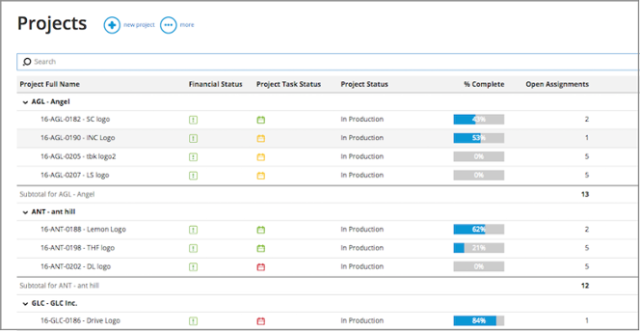
Workamajig is another popular option with creative teams and ad agencies.
Pros: Like Mavenlink and Clarizen, Workamajig is an “all-in-one” tool designed to do more than just project management. It has features not often found in PM solutions, including invoicing and financial tracking.
Cons: Suffering from being an “all-in-one” tool, project management almost feels secondary to financial functions. Workamajig doesn’t have many of the project management features offered by other tools on this list.
Pricing: Ranging from $50/month/user for up to five users to $32/month/user for over 100 users.
12. LiquidPlanner
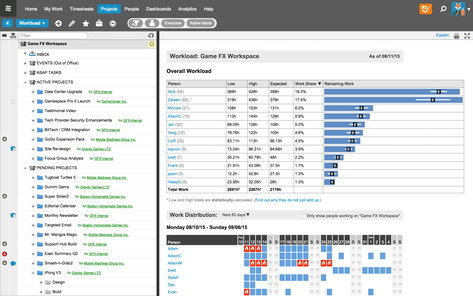
LiquidPlanner makes the list of Mavenlink alternatives because of its self-acclaimed “smarter project management” software.
Pros: LiquidPlanner uses a Gantt chart interface as its main project management view, so if you’re a fan of Gantt charts, you may like this tool. Its software is resource-driven and makes it easy to see the overall progress of your projects and tasks. The tool also includes built-in reporting and time tracking.
Cons: This software was designed for technical users, so onboarding may take a while if your team doesn’t have that background. Also, its onboarding plans cost extra. The tool’s Gantt chart view can make it difficult to see the project details.
Pricing: Starting at $45/user/month up to an Enterprise package
13. Monday
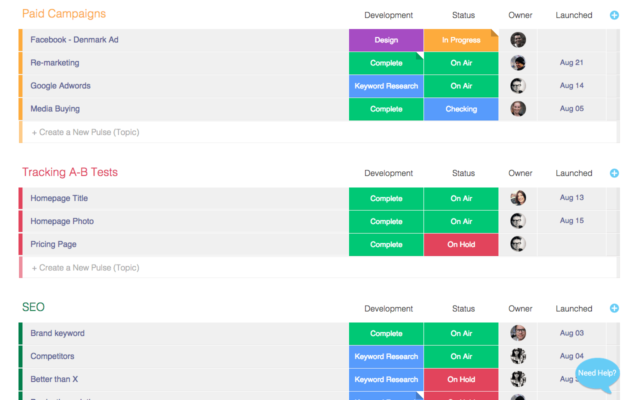
Monday allows for planning, tracking, and delivering your team’s best work in an easy and efficient way. This product launched in 2014 and had to undergo many changes in order to get the success they have earned today.
Pros: The visualization of Monday allows for their users to see views of areas easily, with project and order status available to everyone immediately. Collaboration is integrated into the software, making it easy for teams to communicate with each other about tasks in order to get them completed.
Cons: The steep learning curve that comes with Monday is similar to Mavenlink which makes tasks confusing to new users.
Pricing: Starting at $39/month for 5 users
Looking for other Monday.com alternatives? Check out our list here.
14. Asana
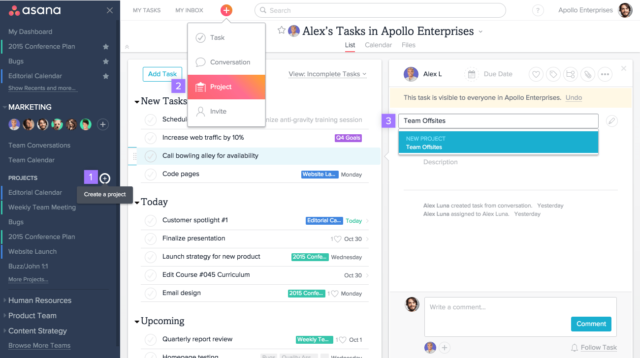
Asana can help your team stay on track of all your projects while communicating and working together.
Pros: Asana is very intuitive and provides a clear outline of what team members are responsible for when completing projects. It is simple to not only assign tasks but also sort them out so your projects stay organized.
Cons: Asana lacks the ability to be able to track certain aspects of your projects. For example, there is no feature to track your expenses that have been incurred by your team, which is important for accounting operations.
Pricing: Free for teams up to 15; Premium ($10.99/user/month); Business ($24.99/user/month); Enterprise (quoted)
Looking for Asana alternatives? Check our list here.
15. TeamGantt
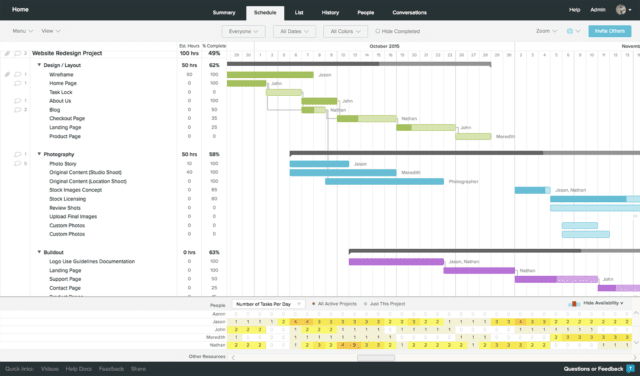
TeamGantt integrates planning and scheduling projects into one software to provide an efficient and productive way for team members to complete various projects. The software helps determine how long a project should take, what you need to complete the project, and how to tackle each step of the project.
Pros: TeamGantt takes simplicity to the next level but also accomplishes a very efficient project management software that is intuitive for users. There are multiple views and tracking tools; Real-time Progress Tracking, Customizable Views, and Resource View, which allows for each project to be viewed from different perspectives.
Cons: The project budget is not represented in TeamGantt. Budget is important for companies to keep track of. This feature can assist the project manager in viewing the task’s budget projections and incorporating that into TeamGantt would improve their software.
Pricing: Ranges from Free–$62/month for up to five users.
Check out our list of top TeamGantt alternatives
16. Basecamp
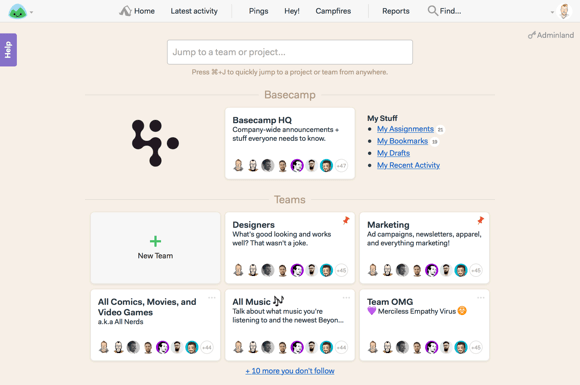
Basecamp is more than just a project management software. It makes working in a team and completing projects seamless. Basecamp is one of the most well-known project management applications among most project managers. Basecamp allows you to communicate with coworkers and clients while making the process easy at the same time.
Pros: Basecamp gives its users the ability to opt-in for auto-updates and notifications. The software gives the option for each team member to control how and when they receive various types of updates, and auto-check-ins keep everyone on the same page.
Cons: Unlike other popular project management software, Basecamp doesn’t have a Gantt chart or Gantt- view in order to create dependencies or relationships between tasks and deadlines, which is critical for project success.
Pricing: Free and Business for $99 per month/unlimited user.
Need more Basecamp alternatives? Check out this list of Basecamp alternatives.
Conclusion
When choosing the best project management solution for your team, remember to consider not only the physical features but also the user-interface, training, and support. This complete list of project management software can help narrow down your decision but if you are looking for specific alternative check out this list!
A robust tool that your team can’t use could create more headaches and problems. To increase project success, you need a solution and provider that will work with your team and get them started on the right foot.
Does your team need powerful project management software that the whole team can use? Workzone may be just the ticket…



